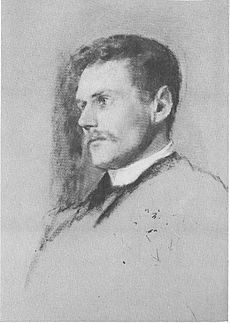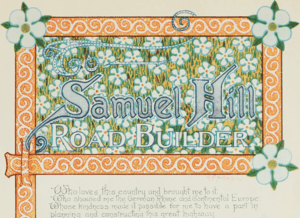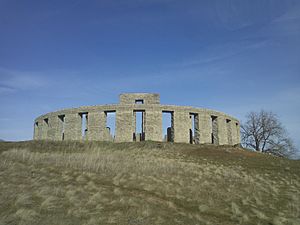Samuel Hill facts for kids
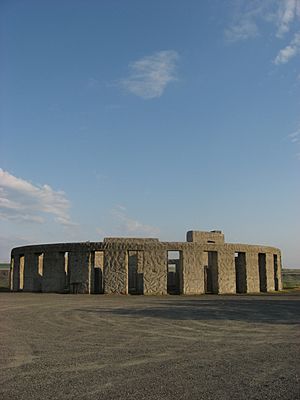
Samuel Hill (born May 13, 1857 – died February 26, 1931), known as Sam Hill, was an American businessman, lawyer, and railroad executive. He was also a strong supporter of building good roads. He played a big part in the economic growth of the Pacific Northwest region in the early 1900s.
Some of his famous projects include the Peace Arch, a monument celebrating 100 years of peace between the United States and Canada. This arch stands on the border between Blaine, Washington, and Surrey, British Columbia. He also founded the Maryhill Museum of Art. While he is perhaps best known for building the Stonehenge replica in Maryhill, Washington, his biggest impact might be his work to promote paved modern roads.
Contents
Early Life and Education
Sam Hill was born into a Quaker family in Deep River, North Carolina. His family had to move because of the American Civil War. After the war, Sam grew up in Minneapolis, Minnesota.
He graduated from Haverford College in 1878, just like his father. At Haverford, he studied Latin, Greek, French, and German. He also learned mathematics, science, English literature, logic, and political science.
In 1879, he spent a year at Harvard University to earn a second bachelor's degree. At Harvard, he continued studying Latin and history. He also took classes in forensics and philosophy. Even though he was only there for one year, he became a very active Harvard alumnus. He served on the Harvard Board of Overseers for several years, which meant he traveled across the country often for meetings. He also joined and sometimes led Harvard Clubs in different cities.
Career and Move to Seattle
After finishing his studies at Haverford College and Harvard University, Sam Hill went back to Minneapolis to work as a lawyer. He won several important lawsuits against the Great Northern Railway. This caught the attention of the railway's manager, James J. Hill, who then hired Sam to work for the railway. In 1888, Sam Hill married James Hill's oldest daughter, Mary.
For more than ten years, Sam played a key role in his father-in-law's businesses. He worked at the Great Northern and was president of the Minneapolis Trust Company. Around 1900, Sam and James had some disagreements. The exact reasons are not fully clear, but they continued to have friendly business discussions.
In 1901, Sam traveled across Russia on the Trans-Siberian Railway. In 1902, he settled in Seattle, Washington. There, he had major investments in the Seattle Gas and Electric Company, which mainly focused on the coal gas business.
Sam had planned to move to Seattle in December 1900. However, his wife Mary did not like the Northwest. After six months, she moved back to Minneapolis with their two children, leaving Sam in Seattle. He stayed and started many new projects in the Pacific Northwest.
A World Traveler
Sam Hill loved to travel the world. He spoke German, French, and Italian fluently, and learned some Russian. He made at least 50 trips to Europe and visited Japan nine times between 1897 and 1922. All of his extensive travels happened when people could only travel by surface vehicles and ships.
In the early 1900s, Hill was the only American member of the Geographic Society of Germany. He constantly collected information about harbor depths and ocean temperatures to map ocean currents. He added this information to special, high-quality globes made in Germany. He ordered these globes many times between 1902 and 1914 and gave them as gifts.
Among his friends from his travels was King Albert I of Belgium. The King made him a Commander of the Crown and an Honorary Belgian Consul for Oregon, Washington, and Idaho. Hill and his friend Joseph Joffre (a French Marshal) traveled around the world together in 1922. He also became friends with Queen Marie of Romania, who gave him the Order of the Crown in the Degree of the Grand Cross. Her visit to the United States in 1926 was largely because Sam invited her.
Sam Hill's Projects
After leaving his father-in-law's company in 1900, Sam Hill started many different businesses and projects. Some were successful, and some were not.
Utility Companies
His Seattle Gas and Electric Company faced tough competition from other utility companies. Eventually, after a price war, Hill was able to sell the company's gas facilities to the Seattle Lighting Company in 1904.
Other attempts at utility companies were less successful. The Home Telephone Company of Portland was one of the first to use rotary dial telephones in the area. However, it eventually lost out to the larger Bell System.
Maryhill Community
Starting in 1907, Sam Hill bought most of a small town called "Columbia" or "Columbus" near the Columbia River in Klickitat County, Washington. He dreamed of building a new community there in the Inland Empire. He named the area Maryhill, after his wife and his daughter, both named Mary. However, neither of them ever lived there.
His first idea was to create a farming community for Quakers. But Sam was the only known Quaker resident. Overall, his effort to create the Maryhill community was one of his least successful investments. He spent at least US$600,000 that he never got back.
Golf Course and Restaurant
A smaller, but successful project was a golf course and a large, simple restaurant at Semiahmoo. This was just north of the U.S.–Canada border and near Hill's Peace Arch. The restaurant was like an early fast food place. During Prohibition in the U.S., the restaurant did well because it was on the Canadian side of the border, where alcoholic drinks could be served legally.
Supporting Paved Roads
Good roads are more than my hobby, they are my religion.
Sam Hill spent a lot of time supporting the building of modern roads in Washington and Oregon. In September 1899, Hill started the Washington State Good Roads Association. This group convinced the Washington State Legislature to create the Washington State Department of Transportation in 1905. He also suggested using convict labor to build roads.
Hill's land around Maryhill was very useful for his road advocacy. From 1909 to 1913, he built 10 miles (16 km) of asphalt-paved Macadam road at his own cost (US$100,000). This was the first road of its kind in the Pacific Northwest. Hill tried seven different paving methods along its length. The part of this road that still exists, now called the Maryhill Loops Road, is usually open to people walking and biking, but closed to cars. It is a popular spot for annual longboard races and downhill bicycle events.
In 1907, Hill convinced the University of Washington to create the first chair in highway engineering in the United States. He could not convince Washington State to build a highway on the north bank of the Columbia River. However, in 1913, Oregon governor Oswald West and the Oregon Legislative Assembly visited Maryhill to see his experimental road. After that, Oregon built the beautiful Historic Columbia River Highway, which connected Astoria, Oregon and The Dalles, Oregon. To honor his influence, a plaque was placed along the Historic Columbia River Highway, at Chanticleer Point, Oregon.
Also, in honor of his work for good roads, the bridge near Maryhill for U.S. Route 97 across the Columbia River was named the Sam Hill Memorial Bridge.
Sam Hill also strongly supported better roads for Japan and friendship between Japan and America. For this, he received the Third Class Order of the Sacred Treasure in 1922.
Monuments and Institutions
Sam Hill built two famous monuments and an art museum. He also bought the private Minneapolis Athenaeum library and gave it to the city.
Maryhill Stonehenge
The Stonehenge replica at Maryhill honors those who died in World War I. Hill built it to remind people that even in modern times, lives are still lost to war.
Maryhill Art Museum
Hill started building a large house at Maryhill. However, it was not finished during his lifetime. This was partly due to money problems and his frustration that Washington State did not build a road on the north bank of the Columbia River to make the area easier to reach.
His friend Loie Fuller suggested that Sam turn the building into an art museum. The museum was officially opened by Queen Marie of Romania in 1926. But it did not open to the public until 1940, nine years after Hill's death.
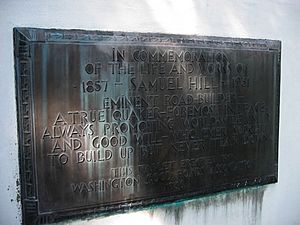
Peace Arch
The Peace Arch, where today's Interstate 5 highway crosses the U.S.–Canada border, celebrates the peaceful relationship and open border between the two countries.
Minneapolis Athenaeum
Hill served as vice president of the Minneapolis Athenaeum, which was a private library. In 1907, he donated a collection of Chinese prints. He eventually bought all the shares of the Athenaeum Company and then donated it to the public Minneapolis Foundation.
Politics
Sam Hill was a Republican and was sometimes active in the party. He did not like Teddy Roosevelt's efforts to break up large companies. He thought William Howard Taft was a bad choice for president, so he openly supported William Jennings Bryan in 1908, and Woodrow Wilson in 1912 and 1916. He later came to disagree with Wilson after World War I.
He generally did not support labor unions.
Personal and Family Life
Marriage and Children
Sam Hill married Marie Francis Hill (also known as Mary Hill Hill) on September 6, 1888. Her father gave them a generous wedding gift, making them wealthy right away.
They had two children: Mary Mendenhall Hill (born July 3, 1889) and James Nathan Branson Hill (born August 23, 1893). Mary was Catholic, and Sam agreed that their children would be raised Catholic. Sam was a Quaker, but he had good relationships with many Catholic clergy members.
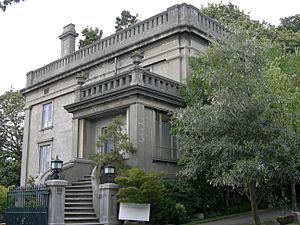
Their marriage faced challenges, and by 1900, when Sam decided to live in Seattle, their relationship was difficult. Mary left Sam in Seattle and moved back to the Minneapolis-St. Paul area with their children. She eventually moved to Washington, D.C..
Mary never returned to Seattle. However, until 1907, Sam continued to visit her in the Midwest or East Coast at least twice a year. He even bought an estate in Stockbridge, Massachusetts, hoping they would stay there together sometimes. But their relationship continued to grow distant. Because Mary was Catholic, divorce was not an option for her.
Mary became increasingly withdrawn. By 1921, she was described as "virtually an invalid," though she lived until 1947.
Their daughter, Mary, struggled with emotional and mental health issues throughout her life and spent much time in institutions. Their son, James N.B. Hill, lived a wealthy life but did not make a significant mark on the world.
Other Children
Sam Hill had other children whom he supported by setting up insurance policies and trusts for them. One son lived in British Columbia. Another child was Elizabeth Ehrens (born December 27, 1914). Her mother was Annie Laurie Whelan, Sam's secretary.
Sam Hill's last child was Sam Bettle Hill (born August 1928, died 1997). His mother was Mona Bell, a reporter. The year before their child was born, Sam bought Mona Bell 35 acres (14 ha) on the Columbia River and built her a 22-room house. This house was later torn down to build the Bonneville Dam.
Death and Burial
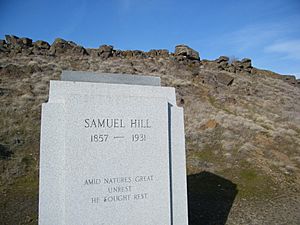
In 1931, Hill went to Salem to speak to the Oregon State Legislature. He wanted to talk about the need to regulate trucks to protect highways. He planned to give a similar speech to the Washington State Legislature. However, he became very ill on the way and died from natural causes at 74 years old.
Hill chose a spot below his Stonehenge replica for his burial site and designed his own monument. His first monument did not last and has since been replaced.
See also
 In Spanish: Samuel Hill para niños
In Spanish: Samuel Hill para niños


